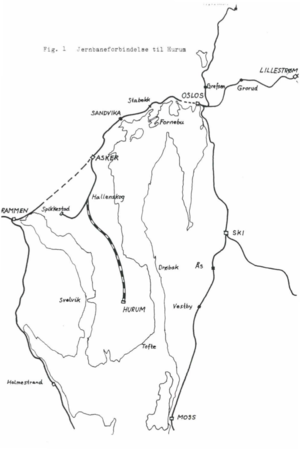Hurum Line
| Hurum Line | |||
|---|---|---|---|
Double | |||
| Character | Passenger | ||
| Track gauge | 1,435 mm (4 ft 8+1⁄2 in) | ||
| Electrification | 15 kV 16.7 Hz AC | ||
| Operating speed | 140 km/h (87 mph) | ||
| |||
The Hurum Line (
Alternative proposals were also made, such as building a bridge over the Oslofjord and connecting it to the Østfold Line, or the use of coaches and hovercraft. There were also proposals for a monorail and a maglev service. The new airport was in 1992 instead chosen to be located at Gardermoen, resulting in the construction of the Gardermoen Line and the abandonment of any plans for building a railway to Hurum.
History
Oslo Airport, Fornebu opened as Norway's main international gateway on 1 June 1939.[1] Fornebu was located 7 kilometers (4.3 mi) from the city center of Oslo, on the peninsula of Fornebu. The cramped location made a suitable runway for intercontinental flights impossible to build and there was no place to build a second runway.[citation needed] A 1970 report proposed building a new airport to serve the capital and Eastern Norway, and mentioned Gardermoen, Hurum, Askim, Nesodden and Ås as suitable locations. Later Hobøl was also proposed.[2] Various discussions were made for a new airport, and from 1972 all charter flights were moved to Gardermoen.[3] The divided solution was accepted by Parliament, and approved a major expansion of Fornebu in 1983.[4]
Political debate resurfaced the following year, after patronage continued to accelerate. The
The
Route
The route via Røyken was based on running trains from
The service would allow for four trains per hour between 07:00 and 23:00, giving sixty-four trains per direction per day. Travel time between Oslo S and the airport was estimated at 35 minutes, which would include stops at Asker Station and Sandvika Station. NSB estimated an annual ridership of 4.95 million, equal to 13,600 per day or 105 per train.[11]
Alternative proposals
A number of alternative modes were launched, including hovercraft, monorail and maglev, although evaluations were never carried out by the government.[12] The latter would involve a shuttle bus from a quay at Hurum and could only serve a limited number of destinations. A more serious contender was basing all public transport on coaches. A 1986 report from the Institute of Transport Economics proposed coach services on both sides of the Oslofjord,[13] and estimated that travel time by coach from downtown Oslo would take 69 minutes, compared to 68 minutes to Gardermoen.[14] In average trains would transport people 30 minutes faster to Hurum than buses would.[15]
An alternative route for the railway was proposed on the east side of the Oslofjord. It was proposed to follow the right-of-way launched in 1873 of branch of the Østfold Line running along the shore of the
Comparison
Hurum and Gardermoen were the two main proposals for a new airport. NSB also developed an alternative to serve Hobøl, which would be built as a branch of the Eastern Østfold Line at Kråkstad.[19] For the proposal at Kroer, NSB devised rebuilding the Østfold Line between Ås and Vestby to serve the airport. Both of these required the construction of the Follo Line to increase capacity on the Østfold Line.[20] If Fornebu was still to be used, NSB proposed building a branch from Lysaker Station on the Drammen Line to Fornebu, alternatively constructing a people mover from Stabekk Station.[21]
NSB made four proposals for a new railway to Gardermoen. The simplest devised constructing a branch from the
Although Gardermoen is located further away than Hurum, the large degree of new,
References
- ^ Wisting (1989): 35–41
- ^ Bredal (1998): 17
- ^ Wisting (1989): 63–65
- ^ Wisting (1989): 80–83
- ^ Bredal (1998): 21
- ^ Bredal (1998): 21–23
- ^ NSB (1986): 1
- ^ Bredal (1998): 39
- ^ Bredal (1998): 23–24
- ^ Bredal (1998): 28
- ^ a b Styri (1988): 53
- ^ Nielsen (1986): 9
- ^ Nielsen (1986): 10
- ^ Nielsen (1986): 17
- ^ a b Nielsen (1986): 18
- ^ Styri (1988): 58
- ^ Styri (1988): 59
- ^ Styri (1988): 41
- ^ NSB (1986): 20
- ^ NSB (1986): 22
- ^ NSB (1986): 15
- ^ NSB (1986): 8
- ^ NSB (1986): 9
- ^ NSB (1986): 10
- ^ NSB (1986): 11
- ^ NSB (1986): 12
Bibliography
- Styri, Hans Jakob (1988). Fakta om hovedflyplass: Gardermoen eller Hurum? (in Norwegian). Oslo: Polarforlaget. ISBN 82-90544-00-6.
- Bredal, Dag (1998). Oslo lufthavn Gardermoen: Porten til Norge (in Norwegian). Schibsted. ISBN 82-516-1719-7.
- Nielsen, Gustav (30 September 1986). Buss eller bane til Gardermoen eller Hurum? (PDF) (in Norwegian). Institute of Transport Economics.
- Norwegian State Railways (October 1986). Hovedflyplass: Jernbane i tilbringingen (PDF) (in Norwegian).
- Wisting, Tor (1989). Oslo lufthavn Fornebu 1939–1989 (in Norwegian). TWK-forlaget. ISBN 82-90884-00-1.

